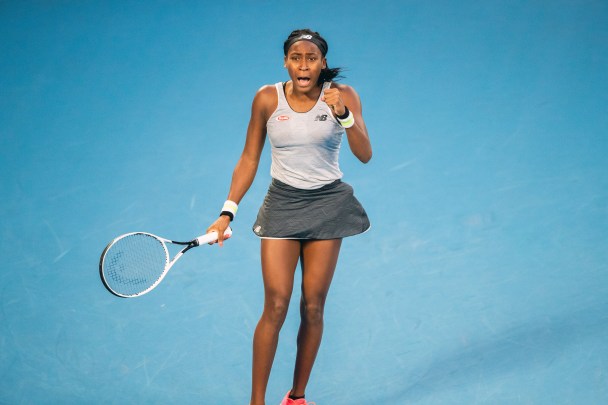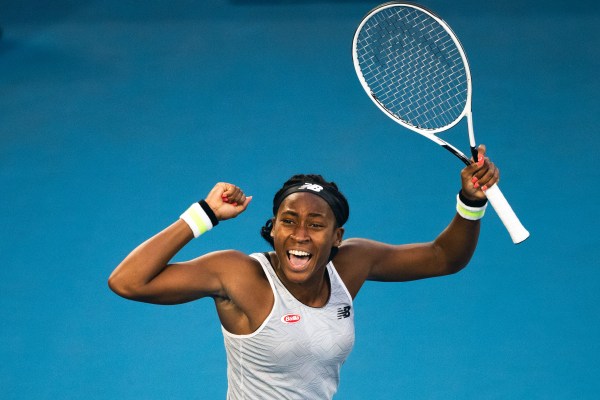Not after the precociously gifted young American once again flashed her prodigious moxie and talent on the biggest of stages. This time it was here at the Australian Open on a warm Friday night, Gauff plowing easily past No. 3-seeded Naomi Osaka on the very court where Osaka won the title last year.
By Kurt Streeter
Coco Gauff is only 15, still growing in every way, and still fresh to the world of professional tennis, but she can win this Australian Open.
That is no stretch.
Not anymore.
Not after the precociously gifted young American once again flashed her prodigious moxie and talent on the biggest of stages. This time it was here at the Australian Open on a warm Friday night, Gauff plowing easily past No. 3-seeded Naomi Osaka on the very court where Osaka won the title last year.
This had been the most anticipated battle of the tournament so far. Average fans and tennis experts alike expected a longer match — and potentially a classic. But it ended in just over one hour and lacked anything like real tension. The last point was typical. Gauff narrowed her eyes, rocked on her back foot, and launched a hard-spinning serve to her frustrated opponent. A short rally ensued. Gauff sent a low, skidding fastball to Osaka’s forehand. Osaka flubbed her reply, dumping it into the net.
The final score: 6-3, 6-4 — a runaway train for the Floridian Gauff, pretty much from the start to the very end.
In the moments just after Gauff won, there was not any of the ecstatic celebrations that she displayed when she announced herself to the world with two stirring Grand Slam runs last summer — first at Wimbledon and then at the U.S. Open — sparking the worldwide phenomenon known cheekily as Cocomania.
This time, as the last point ended, she turned and looked at her family and coaches in their courtside seats, raised her arms, pumped them four times in brief celebration, then walked happily to the net to give Osaka a hug.
Was she more subdued because this is all seeming very normal now? Not a chance.
“I think I was more in disbelief,” she said, referring not just to the pressure of playing the reigning champion but doing it for the first time on the show court, in front of 15,000 fans at Rod Laver Arena. “I didn’t really know what to do. I was just trying to enjoy the moment and savor the moment. I still wouldn’t say I’m used to this.”
She may soon be. The draw is opening up. Early Friday, Serena Williams went down in a heap, the victim of a stunning upset at the hands of the No. 27 seed, Wang Qiang. On Saturday, the No. 2 seed, Karolina Pliskova, joined Osaka on the upset list, bowing to 30th-seeded Anastasia Pavlyuchenkova, 7-6 (4), 7-6 (3).
Gauff’s Round 4 opponent will be the No. 14 seed, Sofia Kenin, who defeated Williams at the French Open last year. Danger lurks at every turn as Gauff enters this part of the draw, but based on the form she showed Friday, she will have a solid chance to emerge victorious against anyone left.
For all of the skill Gauff has and all of the deep, focused concentration she brought to the court Friday night, it must be noted that a surprising stream of unforced errors from Osaka marred the match. She hit 30 in all, an astounding number for a player of her magnitude. Groundstrokes, volleys, overheads, nothing was immune. Osaka looked shellshocked and uncomfortable, her face drawn and uncertain throughout. She would admit later that she simply did not know what to do to play better.
“I was not really swinging freely, and she was,” Osaka said. Though clearly downcast, she was also refreshingly honest, as is her way. Osaka isn’t exactly ready for the geriatric society. She’s 22, after all. But she admitted that she felt the pressure of being the older player by seven years.
“It is just tough,” she said, describing the blanket of pressure she felt. “You don’t want to lose to a 15-year-old.”
“I have an age problem,” she continued. “I don’t like losing to people who are younger than me and there is hardly people younger than me. I took this very personally.”
Osaka also noted that this time around she faced a different Gauff than the overwhelmed opponent who struggled out of the gate and won only three games in their first and only other meeting, in the third round of the U.S. Open in September. That match was remarkable less for its tennis than for the way Osaka embraced and encouraged her tearful opponent on the court shortly after it ended.
This time, Osaka looked at the end like she would be the one in tears. And this time, Gauff was tightly focused and unbowed. More, she looked utterly confident, seeming to own the arena from the moment she took to the court. Once the match got going, she continuously kept her opponent off balance by keeping the ball low, deep and flat.
Gauff won most of the short rallies, and most of the long ones, too: 75% of her first serves went in, and she took 76% of those points. Those are all very solid numbers. They showed she had control of her nerves. “I was pretty composed,” she said, “and really calm.”
For all the latest Sports News, download Indian Express App
Source: Read Full Article








